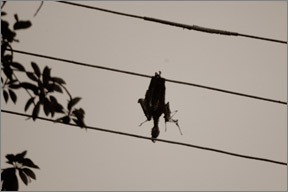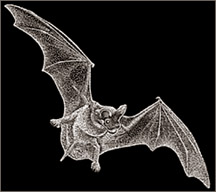Of electricity wires and the sad plight of comic book idols
by Uditha Wijesena
Bats in their mythological role are famous as symbols of darkness and
ghostlike mystery. In Europe and many other cultures demons are pictured
with the wings of bats while fairies and angels are adorned with wings
of feathers.
|

The electricution of the flying foxes |
Bats are victims of many more superstitions in the west, but in
Chinese and other far-eastern cultures they are a symbol of fortune,
happiness and longevity. And of late the 'Batman' a comic book idol.
Bats have been useful to man in some parts of the world as a food
source. The large flying fox weighing over a kilogram is being consumed
by the natives of Africa and Australia even today. This is also the case
in some Asian countries.
The accumulations of their droppings at their roosts have been
collected and used as fertilizer in agriculture and also during war
times as a source of nitrate for gunpowder. They help in pest control in
agriculture during the night but the larger fruit bats themselves are
pests in the orchards.
Sri Lanka has a total of 15 Genera and 30 Species of bats. [Weerakoon
et al-The Fauna of Sri Lanka 2006 IUCN] of them the largest and the most
prominent is the Giant Fruit Bat, Peropus giganteus, more commonly known
as the Flying Fox. The Sinhalese name is Ma-wawula and in Tamil
Periya-vaval.
There isn't much knowledge of the bats in Sri Lanka to the ordinary
layman other than to a biologist who may have studied bats, but for the
day to day encounter of the flying fox that roosts in the open close to
human habitation.
 This bat is active mostly in the evening and night. It has large well
developed eyes for guidance in the night and only sees in black and
white. It does not use high frequency orientation sounds for
echolocation in the dark. It finds its food by smell and will fly to
distances of up to as much as 20 miles to feeding areas. The face looks
that of a fox, thus the name flying fox. It has grayish brown or black
fur on its body with the shoulders often in golden yellow fur. This bat is active mostly in the evening and night. It has large well
developed eyes for guidance in the night and only sees in black and
white. It does not use high frequency orientation sounds for
echolocation in the dark. It finds its food by smell and will fly to
distances of up to as much as 20 miles to feeding areas. The face looks
that of a fox, thus the name flying fox. It has grayish brown or black
fur on its body with the shoulders often in golden yellow fur.
It roosts primarily in trees in very large colonies of up to 800 or
1000 individuals both male and female. However the males have a ranking
order while roosting; the dominant males at the top of the tree and the
subsequent lower ranking males in the lower levels of the tree.
The hierarchy of the males is governed by its size and the strength.
The males retain their roosting position in the tree while the females
move around from day to day. All the more the males are very possessive
of females during the mating season.
The females have a gestation period of 140 to 150 days and give birth
to a single pup that is carried by the mother in flight for up to six to
seven weeks to fly by its self in eleven [11] weeks. The pup is not
weaned until five months.
The flying fox lives mainly on the pulp and juices of the flowers and
fruits of many species of trees in their seasons. Therefore it is
considered an agricultural pest. The seasonal rambutan fruit finds a
death trap to many flying foxes in the Malwana area.
Farmers in these areas were in the habit of illuminating the trees to
ward away the intruding bats, but with the high cost of electricity some
are in the habit of electrocuting the bats.
It is disheartening to hear of such inhuman acts for economic benefit
while bats have been a very vital source in the maintenance and
expansion of forests, by seed dispersion and pollination. At times it is
funny to see intoxicated flying foxes not being able to take wing from
the toddy collecting pots on coconut palms during the toddy tapping
season in the coast.
Other than the killing of flying foxes for food and seasonal
destruction of them on cash crops trees, the electrical power
transmission also takes a fair number of mortalities annually in the
urban areas. One example could be the city of Kandy with one of the
largest roosting camps in the Peradeniya gardens.
The low voltage electricity transmission lines are specified to have
a ground clearance to the lowest transmission line of 5.2 metres. [17
feet] The spacing of the transmission line on the poles is at 300
millimetre intervals. [1 foot] The morphology of an adult flying fox has
a body measurement of nine to twelve inches with a wing span of five and
a half feet.
These measurements are an ideal situation for electrocution of flying
foxes on low frequency transmission lines in the cities. If one is to
observe these rotting carcasses proper they seem to be closer to the
poles or to the space on the lines controlling the sag. Where the sag is
larger the bats escape death.
In developed countries naked wires are no longer used for
transmission. The insulated bundle cables are now used for safety and
efficiency. It is high time we change to these cables in updating our
electricity services in the cities as being done in some cities in Sri
Lanka.
We derive safety standards for humans and in doing so we do not have
a right to ignore the habits and uses of other living beings but to
accommodate them in these standards too, for the simple reason that the
fruit bat gives birth to only one pup in an year and it has a life span
of fifteen years. This however is now definitely shorter with the fast
denuding forest cover, and the dwindling of the available feeding areas
of the flying fox.
***
BAT, is the common name for flying mammals belonging to the order
Chiropetra in biological science. It is derived from the Greek meaning
'hand wing'. Bats, birds and insects are the only animals that can
sustain themselves in the air, and of them it is only the bats that are
entirely a flying group.
There are no bats that cannot fly and they are perhaps the only
animals that commonly live in the deepest and in the totally dark parts
of caves where they hang upside down.
Their hind feet are adapted to hang from twigs or rough surface of a
rock and they hang upside down securely while in deep sleep, in
hibernation or even after death. Bats have a shorter geological history
when compared to birds.
The oldest fossil bird date to about 130-160 million years whereas
the oldest fossil bat is about 60 million years by date. This short
geological history of bats accounts in some measure to their anatomy
being closer to their non-flying ancestors on ground. For example the
bird bones are penetrated by air spaces while those of bats are of the
same basic structure of other mammals.
It has been shown that bats from their evolutionary beginnings have
been auditory animals which listened in the darkness even when they were
of the tree climbing forms that jumped and glided before their
descendants took to the air. The birds on the other hand may have
evolved from ancestors that used their eyes more than their ears.
Scientists have now derived that most bat species find their way in
darkness by emitting high frequency orientation sounds and receiving the
echoes as they bounce off objects.
Bats differ from other mammals as their body temperature and
metabolism fluctuate rapidly and with much ease; when fully awake and
active a bat has a body temperature between 1000 and 1050 F. This is the
case in cold winter air or in hot warm summer and in the tropics.
The large surface area of the wings facilitate heat loss by the blood
vessels dilating to take in more blood in warm conditions and the blood
vessels constricting in cooler climes restricting the volume of blood
flow.
When at rest their body temperature may drop to 800 or 900 F in
summer and to 350 or 400 F in the winter. The activity of an animal is
roughly proportional to its body temperature; a bat cannot fly until its
body temperature reaches 800 F. This is why bats are often found to be
lethargic and fail to respond or fly off for some time after they are
first disturbed. |
